It’s been a month since GDC 2018 and if you visited San Fransisco and perhaps even saw my talk live, thank you! If like most people you missed it, here are the slides and link to the GDC Vault:
Shoestring Soft Launch GDC Vault
The talk focuses on being a practical guide to preparing, running and analysing your games soft launch. Whatever the size and scale of your studio I consider a soft launch critical in the process of creating a successful product on the store. There have been so many different methods to soft launch and so much confusion that I tried to sum it up in a guide. The guide keeps it simple and light and focus’ on the maximum bang for $2000 of spend. A big focus is the idea of bursting a soft launch rather than running an always on campaign, this can save you money and keep your team focused on development rather than watching your numbers all the time. The bigger your studio the more refined your marketing and soft launch tactics might be, but hopefully there is something in there for everyone!
Outline
- Definition of a Soft Launch
- What?
- When?
- Why?
- Before you Soft Launch
- AARRR + GQM Data design
- KPI / Dashboard Setup
- Audience and Location choosing
- Running a Soft Launch
- Bursting
- Analysing
- Critical Decisions
As i’ve been digging deeper into Soft Launching for my upcoming GDC talk, I’ve been asking, When is a Soft Launch complete? How do you know when you’re ready?
These are the hardest questions a Product Owner can ask and the truthful answer is, you will never really know. There are no clear answers, there are no strict redlines or clear benchmarks, at the end of the day it’s a call based on the data you have. Soft launching is all about data. Data comes in from the market and as a PO you have to judge whether you have strong game/market fit. I feel you have four key questions your data must try to answer:
- Are players stuck anywhere?
- Do my players stick at the game?
- Have I stacked some cash?
- Can it scale?
You may not have a clear answer to any of these questions, but you should still be in a position to make a call. Whatever numbers you have you cannot expect them to change by more than 20 percent in either direction.
Stuck
This is the easiest of all the questions to answer initially, but hardest of all to call before launching. This simply requires progression tracking of players based on something that gradually increases as a player plays, such as XP, Levels or Battles. You want to track cohorts of players who are at each stage and see of those players what percentage churn out. You’re looking to see:
- The XP level after tutorial with the biggest churn
- The single point in your funnel with the biggest loss of users
- Any gameplay feature that is used 10 times less frequently than your core loop
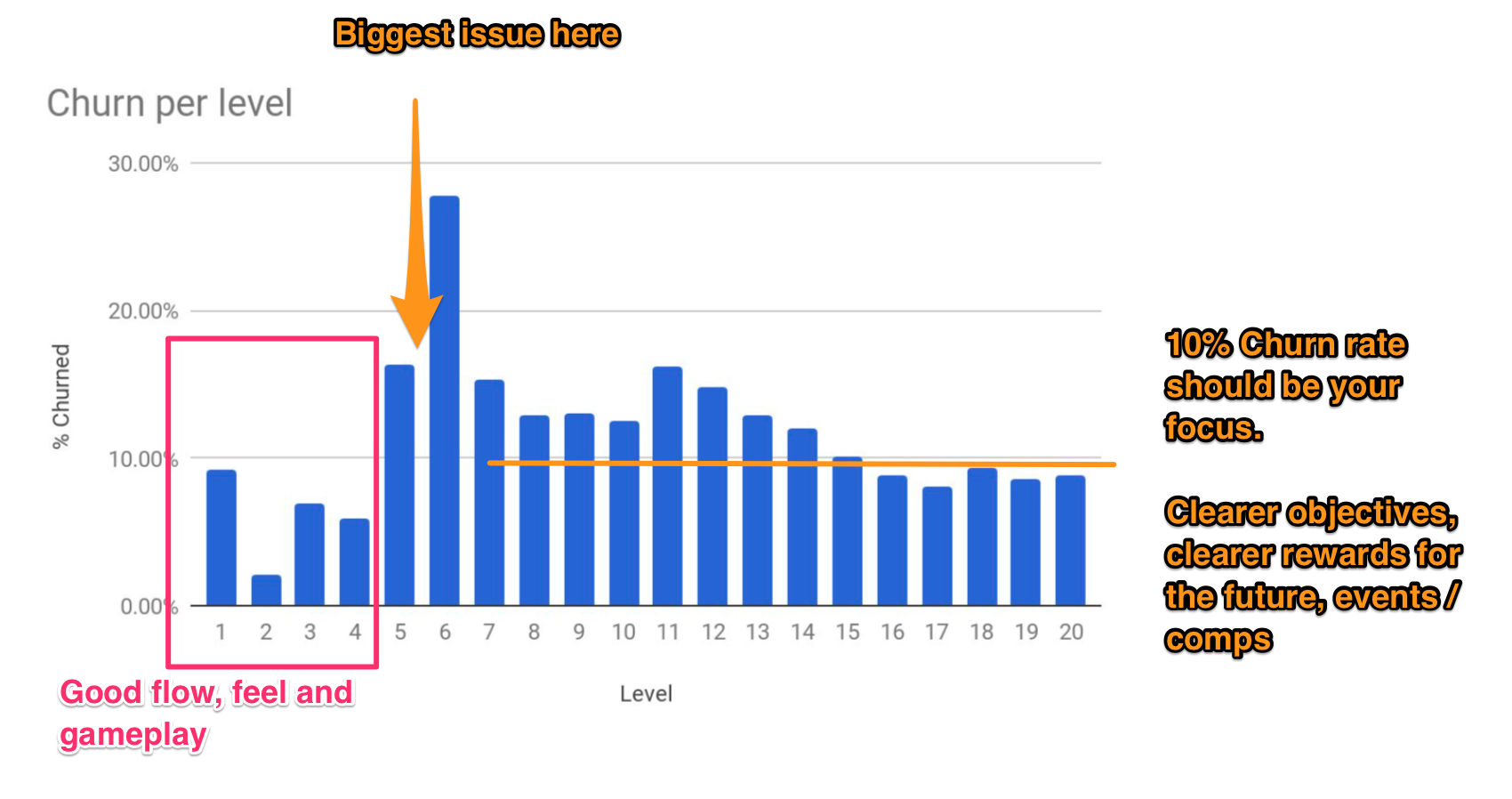
Churn is not directly related to any one feature, but spikes can signify bugs, difficulty issues, lack of clear objectives, or a game that’s devoid of challenge. Keeping a track of your funnels and setting yourself a baseline which you want to stay under will allow you to optimize your game development to areas that are losing the most people.
Stick
If being stuck is all about Churn, then sticking is more about retention. Rather than really looking at your game in terms of a progress, you’re looking at your game in terms of time. All F2P Games need to be playable for long periods of time, and it’s preferable to try to setup a habitual format that players get used to on an hourly, daily, weekly and even monthly timetable.
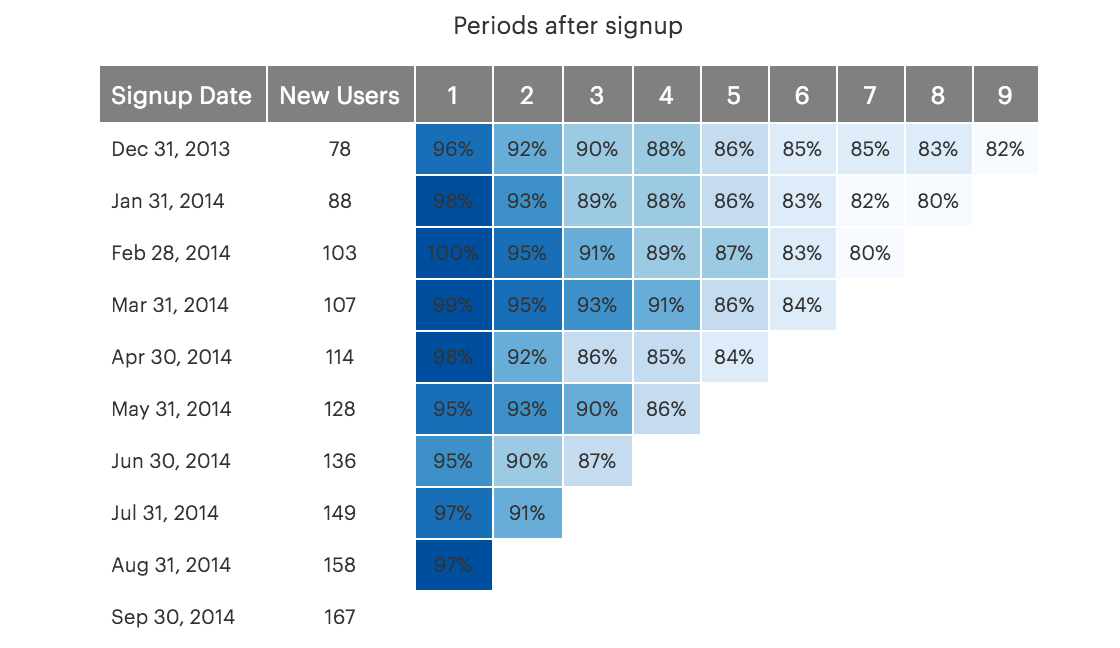
Retention graphs provide the best measure of this. Rather than obsessing about the metric you are at right now, focus on improving it from week to week by analysing weekly cohorts. Each week take the D7, D14, D21, D28 and compare it to the previous weeks during development – the question is, have you seen any improvements? The later day retention figures are much more important, but also very difficult to clear quantify. If you’re game is not improving steadily week on week, you’re missing a feature or the core loop is not holding up well after hundred of playthroughs. This could be down to the core game not having enough Luck, Stats or Skill and requires deeper analysis. You want to see subtle but gradual improvements throughout your soft launch periods.
Stack
Stacking Cash. Quite simply, is your game ROI positive or getting towards ROI positive? You need to look into your marketing spend here and see how the LTV > CPI balance is looking. During soft launch you may not have the data to accurately estimate purchases, or your retention curve and so you amplify those inaccuracies with an LTV calculation. If you’re only just ROI positive when you run a 365d LTV calculation, I would assume you’re wrong.
What you do have at your disposal and with greater accuracy are:
- Total spend Vs Total Earnt (ROI)
- Conversion Rate + ARPPU
- Gems spent in game
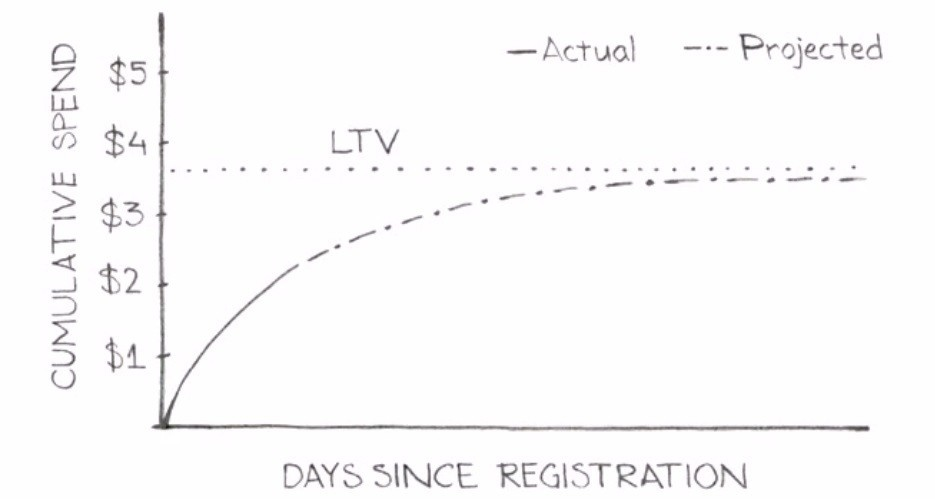
Your ROI will almost certainly be negative. It’s likely to be extremely negative perhaps at 10 percent or less in 30d period. Dependent on how your game is intending to monetize and how your retention curve does look you will need to set a benchmark with what you as a team are happy with and see if it can be improved with each build.
When observing conversion rate and ARPPU look at them as averages for each build. This will give you a fair indicator of what’s likely to happen if your game could scale to more and more people. Use a spreadsheet to work out, what’s the total number of installs we need to keep the lights on? Does this seem feasible with a feature/strong press coverage?
Finally, use your Premium Currency in game to see how quickly or how much spend is happening with your users and what they are spending it on. As very quick reference, the gem spend per user per build should be increasing. Also making sure that the average number of gems in someone’s wallet is low means that people are not hoarding but need to spend them to progress. You’ll have to think about it in your games context but, the more gem spend the better.
Scale
The hardest of all the questions is “will my game scale?” Scale changes lots of things in lots of ways and is a true reflections of a well executed game is one that grows in fun as this scale, e.g. Pokemon Go. So without truly knowing, you have to make gut calls. In my mind, there are are four key piece that your team needs to be aware of:

Marketing – You can test this, it just requires money and it requires you to spend it faster on the marketing platforms. As you increase your bid prices and your spend limit you will speed up installs, hopefully without changing your CPI as virality and organics help. Without going into detail here, you want to try to keep your CPI flat as the rest of your costs and spends increase.
Mechanics – The core game might work for the first 100 levels, but is it simply a matter of adding 100 more? Do you need to add an evolution or twist to the mechanic to keep it fresh? If you do make that change does it break your previous mechanics?
Economy – Almost all economies blow up at some point. You will likely have an imbalance of power or items in the game, but can you detect them? This is what a soft launch will help you to decide?
Content – Is the team ready to handle the technical challenge of doubling or tripling the game? How much time does it take to create a level? How much time does it take for players to complete a level? Can the servers handle it? These are practical questions that if the game is a large success, you are not shocked by the complexity of growing your content.
Conclusion
All the decisions in the world won’t prepare you for abject failure or viral success, but in most cases your game will launch to some acclaim and then face the uphill battle of fixing, smoothing and perfecting the mechanics that work for your audience. The more harsh you are during the early stages of a game’s development, the better you can scale it later on, however, killing a creative endeavour that never hits the app store can be just as costly to your company and mental state. At the end of the day, launching games is why you started game development in the first place sometimes you should go with your gut. Fuck it, ship it.
It’s close to that time of year when everyone in the industry gets ready to take a plane halfway around the world to meet the gaming community at GDC 2018. Personally speaking, it’s one of the only times I see half of my ex-colleagues each year.
It goes without saying that GDC is a very special industry-focused event, not only because it’s the largest, but also because of the sheer density of great game designers and developers who make the trip. Without fail, each year will throw up something new – a new lesson, or a new contact who proves to be invaluable over time.

If you’ve never considered attending GDC before, I couldn’t recommend it any more strongly – it’s easily one of the best games events on the calendar, though the expense required for non-American developers to make the trip cannot be ignored. On that note, try and look into your country’s business investment initiatives, as there may be a budget to get you a ticket, flight or hotel.
For those heading to San Francisco for this year’s she-bang, both I and Adam will be giving two separate talks on topics we’re both passionate about:
GDC Talks
Speaker:
Tom Kinniburgh (Director, Mobile Free to Play)
Location: Room 2006, West Hall
Date: Thursday, March 22
Time: 4:00pm – 5:00pm
In this talk, I’ll be looking through how you can get the best data about your game for the lowest cost. Soft launching is something I believe helps every game improve, but how to do it, when to do it and the costs involve put off a large number of developers. I’ll show how, for $2000, you can get any game ready for a more successful launch on the app stores.
Speakers:
Adam Telfer (Director, MobileFreeToPlay.com)
Anil Das-Gupta (Product Owner, Wargaming.net)
Location: Room 22, North Hall
Date: Wednesday, March 21
Time: 2:00pm – 3:00pm
In this talk Adam and Anil will break down some of the top grossing games on the app store – you’ll have to wait and see which ones they both pick. Deconstructing games is what we do best. We’ll show you how the best performing games create strong core loops and through understanding, you can make better calls in your game.
Mobile Masters Meet Up – GDC 2018
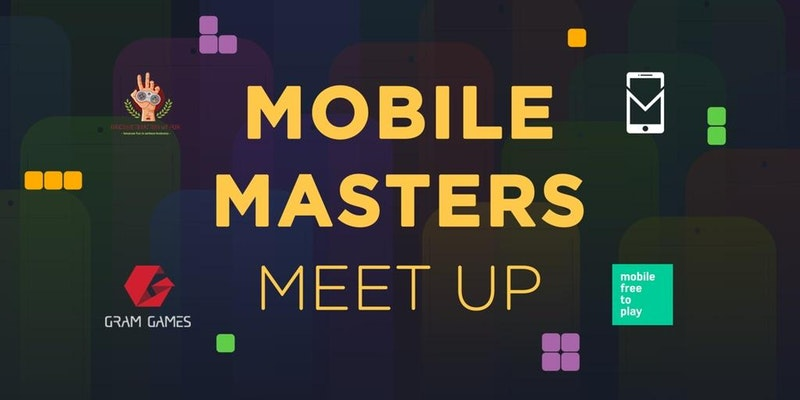
We’re also throwing an invite-only party with Gram Games, MobileDevMemo and Deconstructor of fun. There are really limited spaces and we’re focussing on letting Game Designer and Product Managers in, to meet with other talented folks! Get yourselves on the waiting list and we will be inviting a few people each day.
https://www.eventbrite.co.uk/e/gdc-mobile-masters-meet-up-tickets-43356218617
Hope to see you all there!
Tips for GDC
If it’s your first time to GDC it can seem a little daunting and you can often get lost in the sheer size and scale of the place. Here are my tips.
- Reach out and book meetings early with key individuals. Give yourself 60-minute slots, but only expect to have 30-minute meetings – often traveling to various locations takes the extra time.
- When booking meetings, book around Yerba Buena Gardens or any of the bars or hotels directly next to the Moscone Centre.
- You don’t need to stay near Moscone (nor is it always the safest). You can easily stay farther away at a more affordable venue and commute using the BART or Uber/Lyft. Once you’re in, you’re then in town for the full day and night.
- Work out which talks you want to see in advance and don’t expect to be able to do more than three back to back, they do get quite tiring.
- The Expo hall is a must – make sure you see the indie game finalists.
- Parties are top priority – make sure you try to go to two or three during the week, even if you don’t yourself drink. The best resources for finding them are
- Fellowship of GDC Parties FB Group
- GDC 2018 Party Map
- Don’t party all night. It’s a full week, slow and steady wins the race.
- Bring a bag with a jacket, water, gum, notepad/iPad. The venue doesn’t have great options, and SF weather is very temperamental.
- Don’t wander alone at night. Every year someone at GDC gets into problems wandering alone, especially near the Tenderloin. Stick to groups and take Lyfts/Ubers at night to get home.
- Don’t be shy! If you loved a talk, make sure to go and meet the speaker! If you see someone you admire, talk to them! GDC brings out the best in everyone. You’ll be surprised who is there and who is willing to have a quick chat.
And remember all of the talks are on the GDC Vault after the event and we will be posting both of our slide up here if you can’t make it to GDC this year.
Good luck, and I hope to see many of you out there.
For many developers, player retention is considered the most important metric for a free to play game. Every game company obsesses about reaching higher and higher retention to ensure their user base grows and grows.
On a weekly basis, I hear developers asking “What level of retention should I be aiming for?”, or “What day seven (D7) retention is needed for us to get a publishing deal?” However, the real question they should be asking is, should a single number decide the fate of your latest prototype?
When I think about retention, I like to think of the analogy of Miles per Gallon (MPG) in a car engine: the higher your retention, the higher your MPG, the more efficient your game’s engine. Revenues and marketing are the fuel that power this engine, so my advice is, be sure before you slam your foot on the accelerator.

The key lesson is, games with higher retention get further for less. However, just as there are cars built for many different purposes intended for different users, there are many games for many gamers – not all cars need high MPGs. A hot-rod, might be the fastest car on earth, but it requires a small oil well to keep it running. A family SUV serves multiple purposes at the cost of its efficiency, and a Tesla Model 3 does away with MPG’s entirely.
It is much the same with free to play games: different genres have different retention profiles, and different games monetise at different points in the funnel. Likewise, different business models rely on different audiences engaging for different periods of time.
In each case, there’s not a single retention curve that is the correct model, merely a retention profile that gives signals to where your game is weakest. So, rather than focusing on the numbers themselves, look for the days of the curve which have the biggest relative drop, as this can be the point where you lose people fastest. During a soft launch is the critical point where major decisions to carry on can be decided – it is often retention metrics that decide the fate of your game, but too little focus is given to the even fainter monetisation signals.
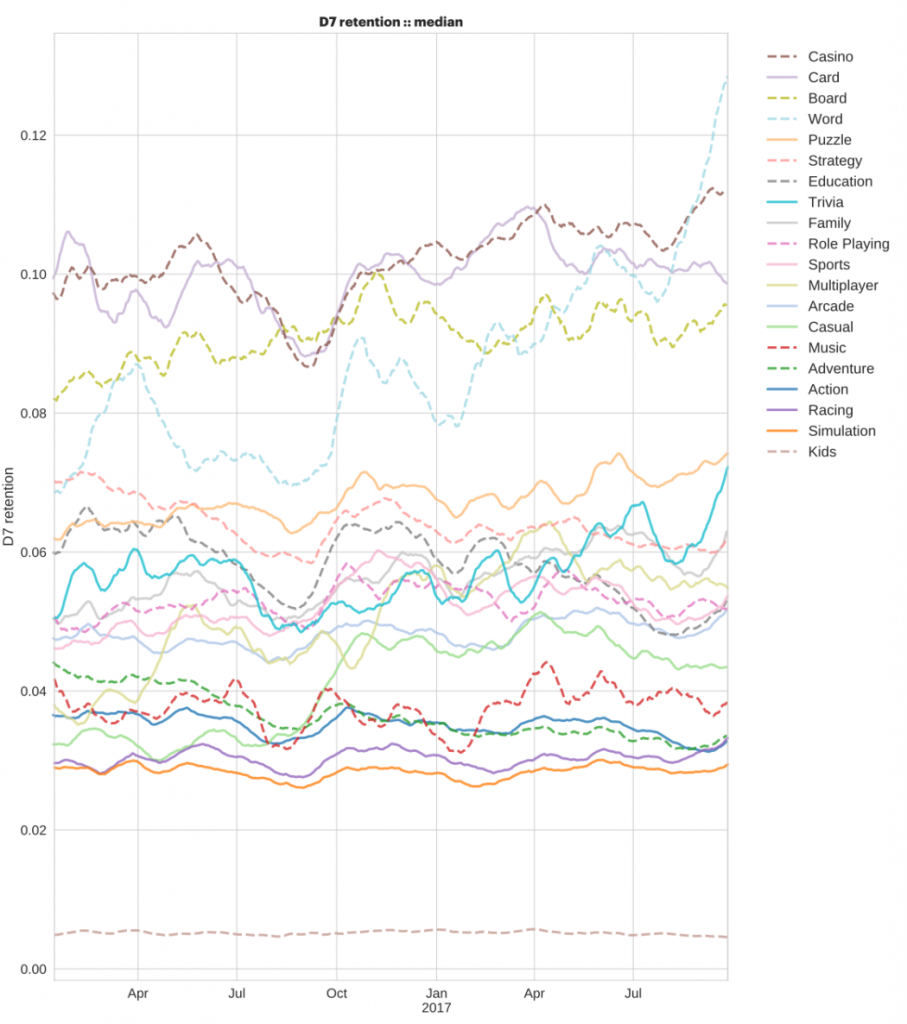
Source – GameAnalytics Mobile Gaming Benchmarks 2016-2017
Monetisation matters
For a free to play game to be a successful product it has to monetize. During the first few days of a new prototype’s launch you will have very few data points to make a call, but you must see some monetisation from some individuals. Focus on the conversion rate and the ARPPU you receive: it’s these two factors help to give a sense of what might happen if the game we’re to scale.
Monetisation only occurs when your game’s system is appealing enough for someone to spend, and the amount they spend is the only real signal you have to how much value your product could create. Spend doesn’t need to equate directly to an IAP, but also how many unique players watched an ad or signed up to a subscription. In each case, the number itself isn’t as valuable as what it results in: Gross Revenue. I would argue that the more important metrics to consider when evaluating early prototypes are Conversion Rate (CR) and Revenue per paying user (ARPPU) as these small signals show that your engine is working.
Returning to the analogy of Miles per Gallon, increased MPGs are a result of a more efficient engine. Conversion Rate and ARPPU are like fueling the tank with gas – the more gas you get the less efficient you need to be. However, it’s admittedly difficult to work out early on just when your engine is ready to take to the streets.
Each metric is only a signal: it gives you a rough overview of your games abilities. In order to build better games, you must focus on the components, not the metrics that show the signal. Only if each component is optimised to its specific goal will you start to see improvements in your metrics, the most general of which is retention. Just like a car engine has pistons, turbos and exhausts that contribute to its overall efficiency, your game has FTUE, Clear UIs and Desirable characters to collect. A real jump in MPGs comes when as a game designer you appreciate the interplay between these features, and realise which of your designs is weakest.
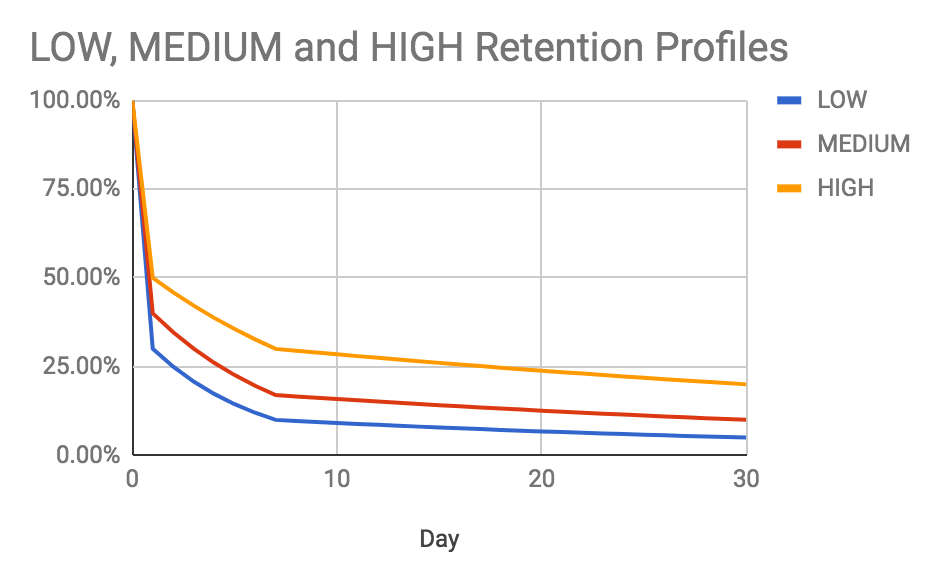
Don’t get me wrong – retention is a fundamental driver of success on any app store, but this obsession with the number your game needs to hit is not how you build a better game. Indeed, improving retention is something we’ve written about it on multiple occasions.
Life Time Value


LTV (Life Time Value) of a gamer is fundamentally what allows you to call a game a success or failure – a high enough LTV allows profitable marketing and growth of your game. However, by its very nature it is an estimation of future value – it can give horribly inaccurate signals early on during testing. There are also many different methods used to calculate it across large time periods.
The equation above focuses on 30D, simplified LTV – LTV is driven on the one hand by revenues (fuel) and on the other side retention (efficiency) with a time estimation for the future value of a player (discount rate). You can read more about methods for calculating LTV here. Too much focus is given to the early retention metrics of the equation, because it’s easiest to gather with small amounts of data, but without any revenue signals being present there is no fuel to grow the LTV.
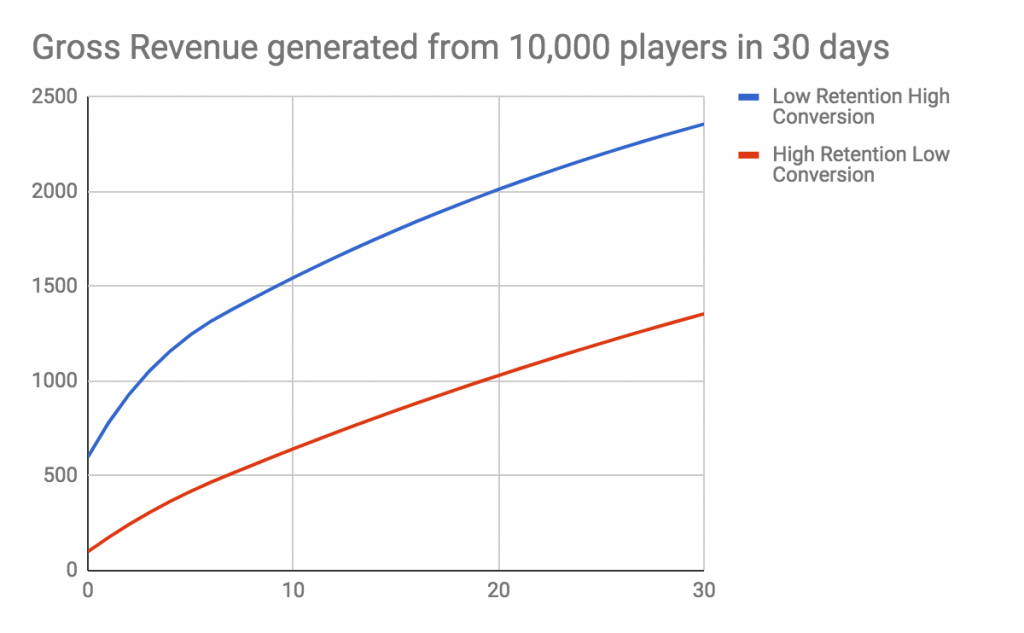
CR and ARPPU are not accurate measures for generating robust models, but they do provide simple signals for game designers.
Conversion Rate is a clear indication of necessity and desire – it’s a signal showing just how many players want to invest in your product, understanding exactly when they bought and what they bought can help you optimise your design funnels to make purchasing clearer for future players.
ARPPU is a strong indicator of pricing and value. You need to ensure that when someone does convert they are giving you the most that they would be willing to pay for content in your game, not converting for an overly generous bargain. Quickly testing multiple price points for your game’s economy can greatly increase your gross revenue.
If you take a look at games with low retention but high CR and high ARPPU then you can still have a workable product on your hands because you’ve seen your gameplay converting players into payers. There may be a huge host of other issues with your funnels and your onboarding, but the fundamental pinch within your system has led to a willing payer. Observing these weak signals early on can give you faith in your early prototype
What retention metrics do tell you
Retention is a fundamental factor in LTV calculations – higher values are always better – but, as we’ve seen, exact figures vary greatly per genre. No matter what your retention curve looks like it won’t directly affect your monetization design. What you ask a player to buy and whether they buy it is a personal decision for each and every gamer. Making that decision clear, simple, desirable and valuable will maximise your conversion.
So what can retention tell you?
Retention metrics are still incredibly useful as gauges for assessing where to focus your game design time. Let’s take D1, D7 and D30 – the most common metrics:
- D1 retention shows me the desirability of your game – fun games are desirable, and people will happily play again tomorrow without the need of much investment or prompting.
- D7 retention shows me the core loop in your game – do they have a clear goal? Do they engage with your systems? Do they form strategies?
- D30 retention shows me whether your core loop scales – Do people have enough content? Can they set long-term goals? Do they get stuck and still want to play more?
In each case, it’s not just the number that’s important, it’s the speed at which the retention drops – the steepness of the curve, if you will. Wherever the steepest drop descends, is where your game is currently weakest. The ideal scenarios is to reach a flat and stable base that is maintained for 60, 90, 180 or even 360 days into the future. When you predict revenues for the long term, even a significantly lower starting retention provides much higher gross revenue over the long term.
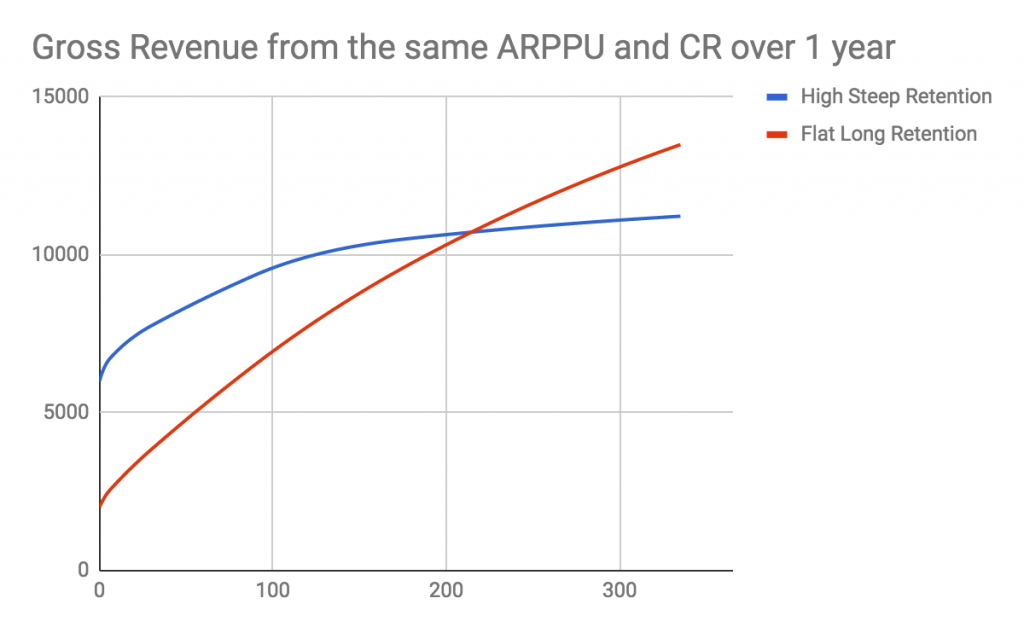
The early ‘wobbles’ in a retention curve point to gameplay issues. For example, your economy may have expanded too much, or the players might simply have reached the end of your content more quickly than you expected. In these cases, you can use these drop off points in the profile to go back and add in more depth to your designs.
Retention is one of the easiest and most reliable metrics to obtain during a soft launch, but don’t let it rule your development, creativity or decision-making abilities – use retention as a barometer to point to deeper issues in your game design. In essence, focus on understanding what is driving your players to spend money. Even the weakest signals can prove that you have a potential product on your hands, so stop focussing on the numbers directly and look for the broader trends – the patterns or fluctuations in the figures – to aid your game design planning. The last thing you want to do is send a great game to the scrap yard.
This year at GDC I spoke about how to soft launch games. A deep dive into how Wooga looks at soft launches, and specifically what you can expect in terms of Cost, Learning and Growth.
Click Here to Download the Slides and watch here if you have GDC Vault Access
Summary & Takeaways:
- Soft Launches have changed significantly
- Soft Launching in 2011 was much easier — especially because of the free traffic through facebook virality
- Soft Launches are more important than ever
- Wooga learned this the hard way with Agent Alice. You have to validate your LTV & CPI before launching if you want to launch with an effective marketing budget.
- Soft Launches aren’t cheap
- Futurama and Max Ammo’s costs were around $250,000 for 5 months of soft launch. This is user acquisition costs only.
- Wooga Soft launches now typically take 4-6 months, this is mainly to give time for both Validation (ensure LTV > CPI) and Growth (attempt to improve metrics before launch).
- You can use Low CPI Countries, but only to test, not to validate
- Don’t use the KPIs ( LTV, Retention ) in your Low CPI test markets to validate your game. Wooga has found that these KPIs change unpredictably from country to country. You can only predict a hit in your key markets (usually Sweden and Canada)
- Retention is more influenced by Marketing User Quality than Features
- Don’t just look at your day-to-day or week-to-week retention to see the impact of your changes. It’s very easy to inflate or deflate your retention profile by adjusting your marketing mix (what % of your users come from which acquisition source).
- The only way to see real impact of your changes in Soft Launch is to A/B test
- If you NEED to see the real impact of features you need to A/B test. But because Soft Launches have such low DAU, the time needed to get real results from this will drag your soft launch timeline out.
- Growth of Retention is SLOW
- We at Wooga typically see an average growth of our retention numbers by 0.5 to 1.5 percentage points per month (1d/3d/7d). So if your retention numbers are far off your target, its going to take a long time to get them up.
- Large Retention Jumps are usually improved with: Funnel Optimization, Tutorials and Difficulty Adjustments
- Large Retention jumps don’t typically happen, unless your game is fundamentally broken.
- The largest bumps in retention that Wooga has seen have come from 3 things:
- Funnel Optimization: looking for where users drop out
- Tutorials: optimizing and paring down the tutorial
- Difficulty Adjustments: looking for frustrations and smoothening progression
- Growth of Monetization can be done
- We at Wooga have seen that monetization can grow, especially during post-launch.
- So if you’re LTV CPI equation is not working only because of monetization, you can still grow monetization during post-launch
Overall:
Soft Launches will not save your game.
If you don’t see strong metrics during Soft Launch, then don’t expect the Soft Launch to give you the clear learnings of how to fix and grow your game to be a hit. Costs are high, Learnings are difficult, and Growth is slow.














